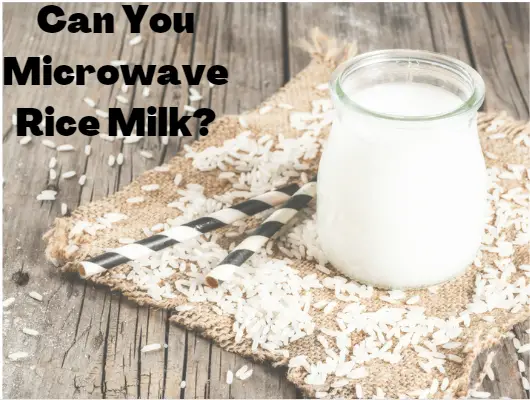How to Microwave Almond Milk: Quick and Easy Steps
Microwaving almond milk is an easy and convenient way to warm it up for your favorite recipes or morning coffee. However, there are some important things to keep in mind to ensure that the almond milk is heated safely and effectively. In this article, I will share some tips and tricks on how to microwave almond milk properly.
Firstly, it’s important to use a microwave-safe container to heat your almond milk. Glass or ceramic containers are usually the best option, as they can withstand high temperatures without cracking or warping. Additionally, it’s a good idea to cover the container with a lid or microwave-safe wrap to prevent splatters and spills.
When it comes to microwaving almond milk, it’s best to use low heat and short intervals to avoid overheating or scorching the milk. Thirty-second intervals are usually sufficient, but you may need to adjust the time depending on the wattage of your microwave. Stirring the almond milk in between intervals can also help to distribute the heat evenly and prevent clumping.
With these tips in mind, you can safely and easily microwave almond milk for all your cooking and baking needs.
What is Almond Milk
Almond milk is a plant-based milk alternative that is made from ground almonds and water. It is a popular dairy-free and vegan option for those who are lactose intolerant or looking to reduce their intake of animal products. Almond milk has a creamy texture and a slightly nutty flavor that makes it a versatile ingredient in many recipes.
How to Make Homemade Almond Milk
Making homemade almond milk is a simple process that only requires a few ingredients. To make your own almond milk, you will need:
- 1 cup of raw almonds
- 4 cups of water
- A blender
- A nut milk bag or cheesecloth
Here’s how to make it:
- Soak the almonds in water for at least 4 hours or overnight. Drain and rinse the almonds.
- Add the soaked almonds and 4 cups of water to a blender. Blend on high for 1-2 minutes until the almonds are finely ground.
- Strain the almond mixture through a nut milk bag or cheesecloth into a bowl. Squeeze the bag or cheesecloth to extract as much liquid as possible.
- Store the almond milk in an airtight container in the refrigerator for up to 5 days.
Homemade almond milk is a great option for those who want to control the ingredients and sweetness level. It is also a cost-effective alternative to store-bought almond milk.
Almond milk is low in calories and contains no cholesterol or saturated fat. It is a good source of vitamin E and calcium, making it a healthy addition to your diet. However, it is important to note that unsweetened almond milk may not provide as much calcium as dairy milk. Be sure to check the label and choose a brand that is fortified with calcium if this is a concern for you.
In summary, almond milk is a nutritious and delicious plant-based milk alternative that is perfect for those who are lactose intolerant or looking to reduce their intake of animal products. Making homemade almond milk is easy and cost-effective, and it can be used in a variety of recipes.

Step by Step How to Microwave Almond Milk
Microwaving almond milk is a quick and easy way to warm it up. Here’s how I do it:
- First, I make sure to use a microwave-safe container. I usually use a glass or ceramic mug, but any microwave-safe container will work. Make sure to check the bottom of the container for a “microwave-safe” label or symbol.
- Next, I pour the desired amount of almond milk into the container. I usually heat up about 1 cup at a time, but you can adjust the amount based on your needs.
- If I’m worried about the almond milk splattering in the microwave, I cover the container with a lid or a piece of wax paper. Alternatively, I can place a paper towel over the top of the container to catch any splatters.
- I microwave the almond milk on medium power for 30 seconds at a time. After each 30-second interval, I take the container out of the microwave and give the almond milk a stir. This helps to ensure that the milk heats evenly and doesn’t develop a skin on top.
- I repeat the microwaving and stirring process until the almond milk reaches my desired temperature. This usually takes about 1-2 minutes in total, depending on the strength of my microwave.
- Once the almond milk is heated to my liking, I remove it from the microwave and give it a final stir. Then it’s ready to use in my coffee, oatmeal, or any other recipe that calls for warm almond milk.
It’s important to note that not all containers are safe to use in the microwave. Avoid using containers made of metal, as they can cause sparks and damage the microwave. Additionally, some plastics may leach chemicals into the almond milk when heated, so it’s best to stick with glass or ceramic containers if possible.
The Microwaving Process
Microwaving almond milk is a quick and easy way to heat it up. Here’s how I do it:
- Pour the desired amount of almond milk into a microwave-safe container with a lid.
- Place the container in the microwave.
- Microwave the almond milk at medium power for 15 seconds.
- Remove the container from the microwave and stir the almond milk.
- Repeat steps 3 and 4 until the almond milk is heated to the desired temperature.
Best Tips for Microwaving Almond Milk
Use the right container
It’s important to use a microwave-safe container with a lid to prevent spills and splatters. I recommend using a glass or ceramic container. Plastic containers may not be microwave-safe and can leach chemicals into your almond milk.
Do not Nuke it
I always microwave almond milk at medium power to avoid hotspots and prevent the milk from boiling over. Heating almond milk at high power can cause the milk to scorch or boil over, making a mess in your microwave.
Stir, stir, stir
Stirring the almond milk between intervals is important to ensure that it heats evenly. This also helps to prevent scorching and boiling over.
Microwave in intervals
I typically microwave almond milk in 15-second intervals to prevent overheating. Overheating almond milk can cause it to curdle and separate.
Don’t overheat
The ideal temperature for heated almond milk is around 140°F (60°C). Heating almond milk beyond this temperature can cause it to lose its flavor and nutritional value.
It’s important to note that microwaving almond milk does not expose it to harmful radiation. Microwaves work by creating an electromagnetic field that causes the water molecules in the almond milk to vibrate, generating heat.
Overall, microwaving almond milk is a safe and easy way to heat it up. Just be sure to use a microwave-safe container, stir the milk between intervals, and heat it at medium power in 15-second intervals until it reaches the desired temperature.
Potential Risks and Precautions
Microwaving almond milk is generally safe, but there are a few potential risks and precautions to keep in mind. Here are some things to consider:
- Burning or overheating: Almond milk can burn or overheat in the microwave, which can cause it to curdle or scorch. To prevent this, it’s important to heat the almond milk slowly and in short intervals. Stir the almond milk frequently to distribute the heat evenly and prevent hot spots.
- Curdling: Almond milk can curdle if it’s exposed to high acidity or high heat. To prevent curdling, avoid microwaving almond milk for too long or at too high a temperature. If you need to heat almond milk quickly, use hot water instead of the microwave.
- Scorching or scalding: Almond milk can scorch or scald if it’s heated for too long or at too high a temperature. To prevent scorching or scalding, use a microwave-safe container and cover the container loosely with a lid or microwave-safe plastic wrap. This will help prevent spattering and allow steam to escape.
- Cancer risk: There have been some concerns about the potential cancer risk associated with microwaving plastic containers. To reduce your risk, use microwave-safe glass or ceramic containers instead of plastic.
Overall, microwaving almond milk is a quick and easy way to warm it up for use in recipes or drinks. However, it’s important to take precautions to prevent burning, overheating, curdling, and scorching. By following these tips, you can safely and effectively microwave almond milk.
Effects on Nutrients and Taste
Microwaving almond milk is a convenient and quick way to warm it up, but what are the effects on its nutrients and taste? As someone who regularly microwaves almond milk, I’ve done some research and testing to answer these questions.
Nutrients
Firstly, heating almond milk in the microwave does not destroy its nutrients. In fact, microwaving is one of the best ways to preserve the nutrients in almond milk. Almond milk is a good source of vitamins and minerals, including calcium, potassium, and vitamin E. Heating almond milk will not change its nutrient content. However, it is important to note that overcooking or overheating the almond milk can cause it to lose some of its nutritional value.
Taste
Secondly, microwaving almond milk can affect its taste. If you microwave it for too long or at too high a temperature, it can burn the nutty particles in the milk and create a strong burnt taste. To avoid this, it is important to use low heat and only microwave the almond milk for short periods of time, checking it frequently to ensure it does not overheat.
Temperature
Thirdly, the desired temperature of the almond milk can also affect its taste. Some people prefer their almond milk to be heated to a certain temperature, such as 140°F or 160°F. Heating the almond milk to these temperatures can change its taste slightly, making it creamier and richer.
Protein Content
Lastly, some people may wonder if microwaving almond milk affects its protein content. Almond milk is not a significant source of protein, so microwaving it will not cause a significant loss of protein. However, it is important to note that almond milk is not a good source of protein compared to other milk alternatives.
In summary, microwaving almond milk is a convenient and easy way to warm it up, but it is important to use low heat and only microwave it for short periods of time to avoid burning or overcooking it. Microwaving almond milk does not significantly affect its nutrient content or protein content, but it can affect its taste if not heated properly.
Alternative Heating Methods
While microwaving almond milk is a quick and easy way to warm it up, there are other methods you can use as well. Here are a few alternatives:
Warming on the Stovetop
If you prefer not to use a microwave, you can warm almond milk on the stovetop. Pour the almond milk into a small saucepan and heat it over low-medium heat. Stir the milk occasionally to prevent it from scorching on the bottom of the pan. Once the milk is heated to your desired temperature, remove the pan from the heat and pour the milk into your mug or glass.
Double Boiler Method
Another way to warm almond milk without using a microwave is to use a double boiler. Fill a small pot with water and bring it to a simmer. Place a heat-safe bowl over the pot, making sure the bottom of the bowl doesn’t touch the water. Pour the almond milk into the bowl and stir occasionally until it’s heated to your desired temperature. This method takes a bit longer than microwaving or stovetop heating, but it’s a good option if you want to avoid using a microwave.
Warming with a Pan
If you don’t have a double boiler, you can use a regular pan to warm almond milk. Fill a pan with water and bring it to a simmer. Place a heat-safe bowl over the pan, making sure the bottom of the bowl doesn’t touch the water. Pour the almond milk into the bowl and stir occasionally until it’s heated to your desired temperature.
Overall, while microwaving almond milk is the quickest and easiest method, there are other ways to warm it up if you prefer not to use a microwave. Whether you choose to warm it on the stovetop, with a double boiler, or with a pan, be sure to stir the milk occasionally to prevent it from scorching on the bottom.
Post-Heating Considerations
After microwaving almond milk, there are a few things to keep in mind to ensure that it stays fresh and safe for consumption. Here are some considerations to keep in mind:
Refrigerate leftover almond milk
If you have any leftover almond milk after heating, it is important to store it properly to prevent spoilage. Place the almond milk in an airtight container and store it in the refrigerator. This will help keep it fresh for up to a week.
Does almond milk curdle when heated?
Almond milk can curdle when heated, especially if it is heated at too high a temperature. To prevent this from happening, heat the almond milk at a medium temperature and stir it occasionally. If the almond milk does curdle, it is still safe to consume, but it may not look or taste as good.
How to tell if almond milk has gone bad?
Almond milk can go bad, just like any other milk. To tell if almond milk has gone bad, check for any changes in color, texture, or smell. If the almond milk smells sour or has a strange texture, it is best to discard it.
Other ways to heat almond milk
While microwaving is a quick and easy way to heat almond milk, there are other methods you can use as well. You can heat almond milk on the stovetop by placing it in a small saucepan and heating it over low heat. Alternatively, you can heat almond milk in a milk frother or a steam wand if you have an espresso machine.
Overall, microwaving almond milk is a convenient way to warm it up, but it is important to keep these post-heating considerations in mind to ensure that the almond milk stays fresh and safe to consume.
Conclusion
Microwaving almond milk is a quick and easy way to warm it up, but is it safe? From my research, it seems that microwaving almond milk is safe as long as you follow a few simple guidelines. Use a microwave-safe container with a lid and heat the almond milk on low or medium heat in 30-second increments, stirring in between. This will ensure that the almond milk is heated evenly and doesn’t scorch or boil over.
What happens if you microwave almond milk? Some people worry that microwaving almond milk will destroy its nutrients, but this is not necessarily true. While heating almond milk can cause some loss of nutrients, the amount is minimal and shouldn’t be a cause for concern. As long as you don’t overheat the almond milk, you should still be able to enjoy its nutritional benefits.
When it comes to the best temperature for heating almond milk, it’s best to keep it below boiling point. Overheating almond milk can cause it to curdle or separate, which can affect the taste and texture. Aim for a temperature that is warm to the touch but not too hot.
In conclusion, microwaving almond milk is a safe and convenient way to warm it up. Just be sure to follow the guidelines above to ensure that your almond milk is heated evenly and doesn’t lose too many nutrients. With these tips, you can enjoy a warm and delicious cup of almond milk anytime you want!
Frequently Asked Questions
Is it Safe to Heat Up Almond Milk?
Yes, it is safe to heat up almond milk. Almond milk can be heated at low to moderate temperatures without any detrimental effects on taste or texture. It is not recommended to heat almond milk at high temperatures as it may destroy its nutrients. Microwaving almond milk is considered one of the best ways to preserve its nutrients. However, it’s important to avoid boiling almond milk, as it may result in a bitter taste. Overall, heating almond milk is a common practice and can be done safely.
How do You Steam almond Milk in the Microwave?
To steam almond milk in the microwave, follow these simple steps:
- Pour your desired amount of almond milk into a microwave-safe jar or container. Make sure to fill the jar only halfway to allow room for expansion.
- Place a lid tightly on the jar to prevent any spills or splatters during the steaming process.
- Shake the jar vigorously for about 20 to 30 seconds. This helps create froth and distributes heat evenly throughout the milk.
- Remove the lid of the jar and place it into the microwave.
- Microwave the almond milk for approximately 30 seconds. Keep an eye on the microwave as heating times may vary depending on the wattage of your microwave and the desired temperature of the milk.
- Carefully remove the jar from the microwave using oven mitts or a towel, as it may be hot.
- Give the jar a gentle swirl to mix any remaining froth into the milk.
- Your steamed almond milk is now ready to enjoy! Use it in your favorite hot beverages or recipes.
Remember, microwaving times and temperatures can vary, so it’s recommended to monitor the milk closely to avoid overheating or boiling.
How long should I microwave almond milk for hot chocolate?
When microwaving almond milk for hot chocolate, it’s important to heat it up slowly and not overheat it. Start by microwaving the almond milk for 30 seconds, then take it out and stir it. Repeat this process until the almond milk is hot enough for your liking. This will help prevent the almond milk from curdling and ensure that it has a smooth, creamy texture.
How can I warm almond milk without curdling it?
To warm almond milk without curdling it, it’s important to heat it up slowly and not overheat it. You can warm almond milk on the stove over low heat or in the microwave by heating it up in 30-second intervals and stirring it in between. You can also add a small amount of cornstarch or arrowroot powder to the almond milk before heating it up, which can help prevent curdling.
Can I heat almond milk for coffee?
Yes, you can heat almond milk for coffee. Almond milk is a great dairy-free alternative to regular milk in coffee. You can heat almond milk in the microwave or on the stove, just like you would with regular milk. Keep in mind that almond milk has a slightly nutty flavor, so it may alter the taste of your coffee slightly.
Is it safe to boil almond milk?
Boiling almond milk is not recommended, as it can cause the almond milk to curdle and separate. If you need to heat up almond milk, it’s best to do so slowly and gently over low heat or in the microwave.
Can I warm almond milk in the microwave?
Yes, you can warm almond milk in the microwave. To prevent curdling, it’s important to heat the almond milk up slowly in 30-second intervals and stir it in between. You can also add a small amount of cornstarch or arrowroot powder to the almond milk before heating it up, which can help prevent curdling.
Can I drink almond milk warmed up?
Yes, you can drink almond milk warmed up. In fact, many people prefer to drink almond milk warm or at room temperature. Just be sure to heat it up slowly and not overheat it, as this can cause the almond milk to curdle and separate.
Related Posts:
- Can You Microwave Coconut Milk? The Right Way to Do It
- Can You Microwave Oat Milk? Is it Safe?
- How to Microwave Rice Milk: Recipe Included!
- Can You Microwave Plant Milk? Yes, here’s how!
- Can You Microwave Milk? Yes, Here’s How!








